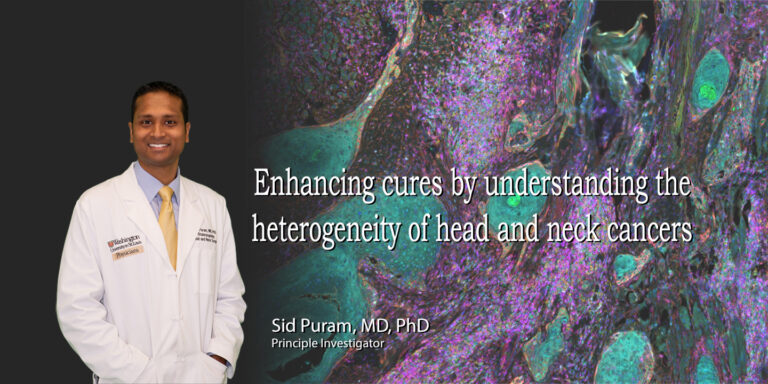Items
Los Tres Paso: Neoadjuvant Palbociclib Monotherapy, Concurrent Chemoradiation Therapy, Adjuvant Palbociclib Monotherapy in Patients With p16INK4a Negative, HPV-Unrelated Head and Neck Squamous Cell Carcinoma
Brief Summary:
The purpose of this study is to evaluate the results of treating patients with HPV-unrelated head and neck squamous cell carcinoma with neoadjuvant single-agent palbociclib, followed by chemoradiation (either cisplatin + IMRT or cetuximab + IMRT depending on patient characteristics), followed by adjuvant single-agent palbociclib.
For more information, contact: Douglas R. Adkins, MD (314-362-4471, dadkins@wustl.edu)
Nab-Paclitaxel and Cisplatin or Nab-paclitaxel as Induction Therapy for Locally Advanced Squamous Cell Carcinoma of the Head and Neck (HNSCC) (APA)
Brief Summary:
In this trial, the objectives are to determine the efficacy and toxicity of induction chemotherapy (IC) with nab-paclitaxel + cisplatin (Arm 1: AP) and with nab-paclitaxel (Arm 2: A) alone in patients with HNSCC, and to compare these data to nab-paclitaxel, cisplatin, and 5-FU (APF). The investigators also hypothesize that the high anti-tumor efficacy of nab-paclitaxel in HNSCC is due to the upregulation of macropinocytosis, a result of the frequent presence of Ras and PI3K (and epidermal growth factor receptor -EGFR) activation in this cancer.
For more information, contact: Douglas R. Adkins, MD (314-362-4471, dadkins@wustl.edu)\
Peng Lab
Our mission is to understand the role of the immune system in the pathogenesis of cancer and age-related neurological disorders, and then to develop effective strategies for the manipulation of immune cell fate and function to provide disease prevention and immunotherapy.

Puram Lab
We are a translational/basic science laboratory devoted to understanding the transcriptional and epigenetic heterogeneity of head and neck cancers. By understanding the mechanisms underlying the growth, development and spread of these cancers, we hope to develop new
diagnostics and therapeutics to treat this devastating disease.

Rutherford Lab
Sensory encoding and excitotoxicity
The Rutherford Lab is focused on sensory encoding. We study how sound is transduced by the inner ear into action potentials in the auditory nerve through mechanisms of synaptic transmission. During overexposure to sound, excessive release of glutamate from the sensory receptors (inner hair cells) drives an excito-toxic response resulting in synaptic disintegration and auditory nerve degeneration. Our experiments are testing hypotheses about the mechanisms of glutamatergic excitotoxicity in the cochlea.
Sensory Regeneration Lab
Sensory transduction in the inner ear is mediated by mechanoreceptive hair cells. Unfortunately, hair cells can be injured or lost after exposure to noise, ototoxic drugs, or as part of normal aging. Such injury typically results in permanent hearing loss and/or disequilibrium. Our research focuses on the biological mechanisms that regulate the production of hair cells and the survival and growth of their afferent neurons.
Sheets Lab
Our laboratory's goals are to understand how specific pathological changes occur in hair cells exposed to noise by defining the dynamic cellular processes that lead to hair-cell synapse loss and hair-cell death. We investigate these questions using zebrafish as a model for human hearing and deafness.
Tye-Murray Lab
The Audiovisual Speech Lab conducts research with both children and adults, who have normal or impaired hearing. One focus is how the brain combines auditory and visual speech information, using both behavioral and fMRI methodologies. A second focus is the use of computer games to develop listening and auditory brain skills (www.clearforears.com).
Yakusheva Lab
The goal of our research is to study the role of the vestibulo-cerebellum in motor control, balance and spatial navigation. The vestibulo-cerebellum is a region of the cerebellar cortex that comprises the floccular lobe and the posterior vermis. Currently, our lab is testing the hypothesis that the floccular lobe computes a forward model (predictive model) of the eye movement from vestibular and efferent copy information, and that the posterior vermis computes an estimate of our heading (translation) and orientation in space from semicircular canals and otolith information. Our experimental techniques include single unit recordings, pharmacology, behavioral neuroscience, mouse neurogenetics, histochemistry and computational modeling.